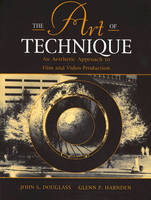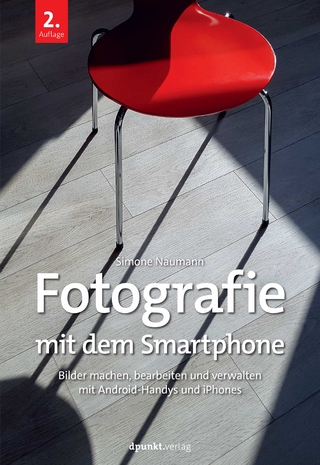
The Art of Technique
Pearson (Verlag)
978-0-205-14248-4 (ISBN)
- Titel ist leider vergriffen;
keine Neuauflage - Artikel merken
This book provides teachers and students with a teaching tool not currently available. It fills a gap in the literature by going beyond simple discussions of hardware usage, basic technical knowledge, and descriptions of technique to in-depth discussions of how this knowledge can be applied in a coherent approach to production. Using an easy to understand, building block approach, the book begins by isolating elements of film and television into twelve discussions of production techniques, represented by the book's twelve chapters. By learning hands-on skills and techniques, students learn to create significant works with a high degree of craft. Once basic instruction on theme and treatment, mood, and characterization is completed, Douglass and Harnden discuss symbols and significance, informing students how to design meaningful, moving works on film. The Art of Technique teaches students to create believable, significant films and videos, and helps them to develop a sophisticated and mature visual approach.
Forward
1. Treatment and Interpretation.
Interpretation.
Treatment of the Subject Determining Purpose Discovering Theme Employing Technique Exercising Imagination and Originality.
Virtual Reality.
Treating Reality in Documentary.
Intention.
The Written Treatment Interpreting the Script.
Personal Style.
2. Ideas.
The Story Tellers.
Conflict and Mood.
Jack the Giant Killer Prince and the Pauper Clash of the Titans The Peacemaker Triumph of Courage Tempting Fate Role Reversals Fish Out of Water Strange Bedfellows Buddy Pictures Ship of Fools The Quest Portraiture.
Stories.
Your Experiences Other Sources for Story Ideas Stories for Episodic Television Inspiration.
Lack of Inspiration.
Research.
Story Research.
Location Research Library Research.
Interviewing Synthesizing Research.
Visualization.
Motifs and Symbols.
3. Point of View.
The Points of View.
POV Shots Perspective.
First Person Second Person Third Person.
Character Point of View Attitude.
The Audience's Point of View.
Defining the Audience.
4. Story/Narrative Structure.
The Rules of the Game.
Beginning, Middle and End.
The Beginning The Middle The End.
Rising Action.
The Inciting Incident The Crisis The Point of No Return The Climax A-Story and B-Story/ Plots and Subplots.
Other Formats.
Skits A Day in the Life Portraiture A Special Place.
Constructing the Structure.
Structuring and Idea.
Log Lines: The TV Guide Version Beats: The Story Steps.
Structuring the Production.
A Real Time Medium.
Pauses Creating Expectation Pacing.
Sequences: The String of Pearls.
5. Mood.
Treatment of Mood.
Location and Setting.
Color, Texture, and Design.
Lighting.
Camera Framing, Angles and Movement.
Lens Focal Length.
Editing.
Montage.
Sound.
Sound Effects Voice.
Performance: Talent and Direction.
Putting It All Together.
Exercise.
6. Characterization and Portraiture.
A Question of Balance.
The Quest for Personality.
Physical Features Sociological Situations Psychological Profile Vitality and Power Lasting Relationships Secondary Characters.
The Treatment of Character in Production.
Preproduction: Casting Production.
Setting/Arena Props Other Characters, Narration and Commentary First Action Lighting Image Size and Camera Movement.
7. Mise en Scene and Design.
The Philosophy of Mise en Scene.
The Material Content of Shots.
The Production Elements of Mise en Scene.
Evocative Locations and Photographic Opportunities.
Creating a Catalog of Visuals.
Visual Story-Telling The Look of the Production Designing the Frame.
Shooting Mise en Scene.
Day Exteriors Night Exteriors Interiors Set Dressings and Props Costumes Lighting.
Contrast Ratios Lighting Ratio Hard and Soft Lighting.
Design.
8. Using the Camera for Interpretation.
Lensing the Image.
The Eye of the Beholder.
Inside the Fourth Wall Visual Variety.
Camera Placement.
Framing.
Wide, Medium, and Close-Up Shots.
Angles.
Frontal Angles High and Low Angles.
Focal Length.
Short Focal Length Normal Focal Length Long Focal Length.
Focal Length and Portraiture.
Camera Movement.
The Moving Point of View.
Specific Compositions Motivating the Move.
Executing the Move.
Complex Moves.
Camera Mountings.
The Hand-Held Camera Tripods Dollies.
Composition.
Dynamic Composition Rule of Thirds The Compositional Triangle.
Point of View.
9. Editing for Interpretation.
Salvaging the Production.
Creating Materials to Edit.
Shooting for Continuity Editing.
Jump-Cuts Off-Screen and On-Screen Action Cut-Aways Cut-Ins or Inserts The Match-Cut Intentional Jump-Cuts Master Scene By-Threes Multiple Camera A Marriage of Styles.
Shooting for Montage Editing.
Montage Theory Montage Editing American Montage.
Rhythm POV and Other Setups.
Confusion vs. Mystery.
10. Lighting for Interpretation.
Lighting Designs versus Lighting Setups High Key and Low Key Lighting Designs Lighting Instruments and Shading Devices.
Hard Light and Soft Light.
Lighting and Contrast.
Contrast Ratios Lighting Ratios.
Lighting Setups.
Narrow Lighting Setups Broad Lighting Setups Cross- Lighting Setups Backlighting Eyelights Set Lighting.
Lighting for Movement.
Exterior Lighting.
Scene Duplication Exercise.
11. Symbols.
Film as Symbolic Expression.
Semiotics.
Symbolic Communication.
Symbolic Expression Significant Detail.
Denotative and Connotative Symbolism.
Cultural Icons.
Creating Internal Symbolism.
The Surreal Landscape.
12. Significance.
Significant Events.
Gut Reaction Events That Arouse Passion.
Audience Conflict.
Meaning in Events.
Portents and Importance The Mirror of Production.
Entertainment.
The Dark Side The Lighter Side So What? Creative Vision and Coherent Productions.
The Power of Performance.
Plastic Reality.
Responsibility.
Production as Artifact The Role of Dialogue.
Once is Enough.
Making Moving Pictures.
Appendix I Electricity.
The Formula.
Volts Amps Watts Circuits.
Appendix II Measuring Light.
Index.
| Erscheint lt. Verlag | 17.1.1996 |
|---|---|
| Sprache | englisch |
| Maße | 232 x 176 mm |
| Gewicht | 513 g |
| Themenwelt | Kunst / Musik / Theater ► Film / TV |
| Kunst / Musik / Theater ► Fotokunst | |
| Sachbuch/Ratgeber ► Freizeit / Hobby ► Fotografieren / Filmen | |
| Sozialwissenschaften ► Kommunikation / Medien ► Medienwissenschaft | |
| ISBN-10 | 0-205-14248-6 / 0205142486 |
| ISBN-13 | 978-0-205-14248-4 / 9780205142484 |
| Zustand | Neuware |
| Informationen gemäß Produktsicherheitsverordnung (GPSR) | |
| Haben Sie eine Frage zum Produkt? |
aus dem Bereich


